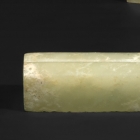J.J. Lally & Co., Oriental Art / New York City, New York
Menu70.
A THINLY CARVED JADE TUBULAR FITTING
Han Dynasty (206 B.C. – A.D. 220)
the finely finished tube with flat base, well hollowed with a wide oval channel, the domed upper section divided in half by a straight groove down the middle, pierced for attachment at the center with two pairs of tiny apertures through the base and low on the sides, very closely aligned to the sharp angle defining the edge of the base.
Length 3 1⁄2 inches (8.9 cm)
A thinly carved jade double tube excavated in 1994-5 at Shizishan and now in the Xuzhou Museum, Jiangsu province, is illustrated by Lin (ed.) in the catalogue of special exhibition organized by the Fitzwilliam Museum University of Cambridge, The Search for Immortality: Tomb Treasures of Han China, London, 2012, pp. 182-183, no. 72.
Compare also the jade tubular fitting of the same size, also pierced at the center for attachment, excavated in 1982 from a Han dynasty tomb of the Guangling Kingdom in Yangzhou, Jiangsu province, now in the collection of the Nanjing Museum, illustrated by Xu (ed.) in Han Guangling guo yuqi (Jade Wares of Guangling in Han Dynasty), Beijing, 2003, p. 122, no. 99.
漢 玉管 長 8.9 厘米
